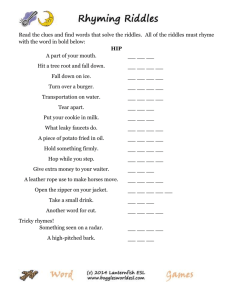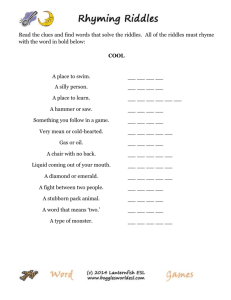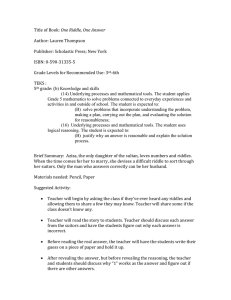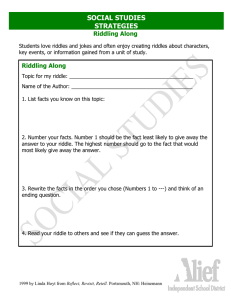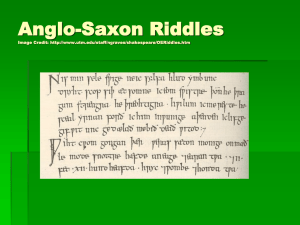The Pedagogical Perspectives of Idoma "Ogbobitaa" or "Descriptive Riddles"
advertisement
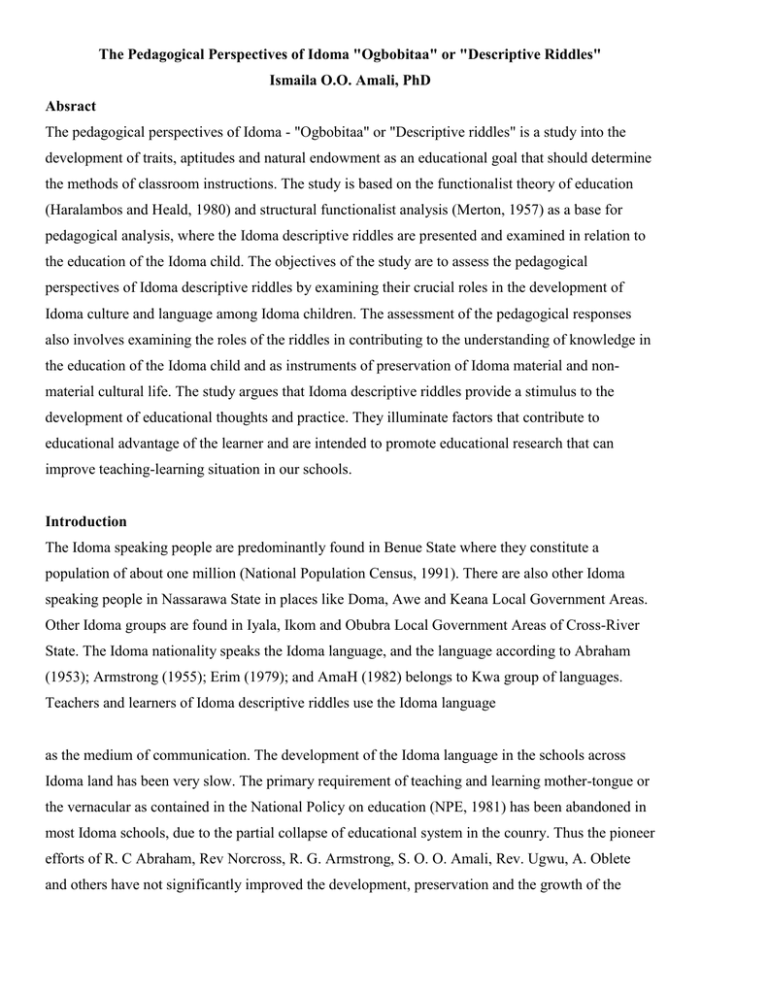
The Pedagogical Perspectives of Idoma "Ogbobitaa" or "Descriptive Riddles" Ismaila O.O. Amali, PhD Absract The pedagogical perspectives of Idoma - "Ogbobitaa" or "Descriptive riddles" is a study into the development of traits, aptitudes and natural endowment as an educational goal that should determine the methods of classroom instructions. The study is based on the functionalist theory of education (Haralambos and Heald, 1980) and structural functionalist analysis (Merton, 1957) as a base for pedagogical analysis, where the Idoma descriptive riddles are presented and examined in relation to the education of the Idoma child. The objectives of the study are to assess the pedagogical perspectives of Idoma descriptive riddles by examining their crucial roles in the development of Idoma culture and language among Idoma children. The assessment of the pedagogical responses also involves examining the roles of the riddles in contributing to the understanding of knowledge in the education of the Idoma child and as instruments of preservation of Idoma material and nonmaterial cultural life. The study argues that Idoma descriptive riddles provide a stimulus to the development of educational thoughts and practice. They illuminate factors that contribute to educational advantage of the learner and are intended to promote educational research that can improve teaching-learning situation in our schools. Introduction The Idoma speaking people are predominantly found in Benue State where they constitute a population of about one million (National Population Census, 1991). There are also other Idoma speaking people in Nassarawa State in places like Doma, Awe and Keana Local Government Areas. Other Idoma groups are found in Iyala, Ikom and Obubra Local Government Areas of Cross-River State. The Idoma nationality speaks the Idoma language, and the language according to Abraham (1953); Armstrong (1955); Erim (1979); and AmaH (1982) belongs to Kwa group of languages. Teachers and learners of Idoma descriptive riddles use the Idoma language as the medium of communication. The development of the Idoma language in the schools across Idoma land has been very slow. The primary requirement of teaching and learning mother-tongue or the vernacular as contained in the National Policy on education (NPE, 1981) has been abandoned in most Idoma schools, due to the partial collapse of educational system in the counry. Thus the pioneer efforts of R. C Abraham, Rev Norcross, R. G. Armstrong, S. O. O. Amali, Rev. Ugwu, A. Oblete and others have not significantly improved the development, preservation and the growth of the Idoma ethnographic works and "mother-tongue" education. R. G. Armstrong and S. O. O. Arpali have remained the only pioneers in the development of Idoma bilingual texts where Idoma and English are presented pari passu (side by side) in some of their studies to help and to encourage the development and growth of Idoma or mother-tongue education in Idoma land. Paradoxically; the multi-ethnic nature of Nigerian state requires that greater emphasis should be given to ethnic studies by scholars of relevant calling. This would assist in the development of inter-ethnic understanding and cooperation. It is on the basis of these facts that this study sets out to examine the pedagogical perspectives of Idoma - "Ogbobitaa or Descriptive riddles" as an input to the development and growth of Idoma studies. The Meaning and the Concept of Idoma Descriptive Riddles "Ogbobitaa" The Oxford English Dictionary defines a riddle as a question in a dark or puzzling manner, and propounded in order that it may be guessed or assumed especially as a form of part-time, an enigma, or dark saying. Likewise, "Ogbobitaa" is the Idoma (Otukpo) word for riddle. Etymologically; the word "Ogbo" in Idoma literally means "arena"; "bu" means "to dig or dig"; while "ita" means "proverb". Conjunctionally "Ogbobitaa" literally means "the arena where proverbs are dug out" or "the arena for digging out the meaning of proverbs". Thus, Finnegan (1980) has classified riddles into three forms or types. These are: a) Descriptive riddles b) Shrewd witty words and c) Idiophones and nonsense words suggesting some acoustic images. In the Idoma society; riddles are meant mainly for children of primary school age. Since the indigenous Idoma educators knew that the child was a product of his total environment, a wide range of environmental data was presented to him as instructional materials. They involved a play of images, visual and learning, Thus, the "Idoma descriptive riddles or Ogbobitaa" are always stated in a simple form of phrase or a simple statement referring to some well known objects using more or less veiled language to ease the problems of lack of understanding among the children. The Contents of Idoma Descriptive Riddles or "Ogbobitaa" Molmar (1981) notes that every system of education up to the present has been a function of the life of culture. Again, that youth should be gradually associated with what the best of minds of former ages have created in the fields of science, literature, speculations and the arts. It is therefore useful that indigenous educational planners and men of ideas in Idoma society do not leave the value of the culture as they have found them but consider them as commodities to be used, manipulated for effective imparting of knowledge in our ever growing children. Thus, the contents of Idoma descriptive riddles include every sphere of natural and human life of the Idoma society. These include various phenomena such as the characteristic of persons, places, plants, animals and the other naturalia. Specifically it can cover areas like parts of the human body, agricultural crops or implements and implements of Idoma domestic life. It can also be drawn from the animal, vegetables and crop world. Further, it can cover natural phenomena like the moon, stars, rain, water, cloud, mountain, fire and stones, etc. Thus riddles are used to introduce the child to the material and non-material culture of the Idoma people. It is an education that is laid on the foundation of the child's cultural environment (Amali, 2000). Most of the Idoma descriptive riddles give vivid visual impression, particularly those drawn from the natural world which often indicate close observations made on them by the indigenous Idoma educators (Amali, 1980). The Traditional Structural-Functional Perspectives of Idoma Descriptive Riddles or "Ogbobitaa" Education is not accidentally related to culture in the traditional society. Education is planned, taught and learned in a given at a point in time and at a given time. Education is also structured to the needs of the learner and his society. In accordance with the pragmatic premises, Idoma descriptive riddles would be predicated only on ideas that have 'made good' in the context of western school. However, it is note that the pedagogical approaches to Idoma descriptive riddles independent educational goals, it has its own trait, structure, aptitude classroom instruction. The function of Idoma descriptive riddle - or "Ogbobitaa" - is not fulfil a specific purpose that cannot be accomplished elsewhere but to a vague set of communal activities that blend into the Idoma social landscape and indistinguishable from it. Thus, in the Idoma society, descriptive riddles are stated in brief question and answer forms which supply a frame reference for the pupil's answers. They are usually stated as prelude to commencement of more serious and elaborate narrations of folktales storytelling in the evening where they serve to: a) provide a source of amusement for children which help them to relieve their tension before the long evening folktales or story telling begin b) sharpen children's wit c) train children's memories d) develop children's language and e) e) develop their intellectual skills and abstract reasoning especially teaching children indirect means of communication, e.g 'Aameh 0 pileyi Ie", literally meaning 'Aameh with a beard head" and is referred to 'Api" or "the penis (circumcized)". The "snake" or "Egwa" is likewise referred to as "the rope of thing of the ground" or "Ongbodaaje". Farrant (1981) has noted that such education helps in the cognitive development of the children. The School There is no clear line of demarcation between the home and the school where Idoma descriptive riddles are taught and learned. An open air in an Idoma family compound is used as the school for teaching and learning but usually children stay at a safe distance from their parents. The School Period The school usually starts after evening meals, but the riddling schools start much earlier than the folktale or storytelling period (usually between 7: 30pm ..8:30pm). . The Class The class is usually composed of children (boys and girls) of primary school !age who come together to sit either in circle or forming an arc. The teacher sits at the centre of the circle formed by the pupils (Diagram A) or at the centre of the arc (Diagram B) to have effective control of the class. The teacher Diagram A The teacher Diagram B The Class Teacher The class teacher is usually a bigger person (male or female) who would have passed through the same kind of riddling class and possesses enough experience to control the class. The teacher can also be an adult who wishes to keep the children busy before they proceed for the actual evening storytelling. He is required to possess more knowledge of the subject than the learners. In the absence of a clear adult or teacher, the children break into two opposing groups and hold the class by cross-examination of each other's group. The Scope of Learning Experience The knowledge of the characteristics of plants, animals and other the child's environment are essential for effective performance.is purported to be inculcated is to be the need of the individual and the Idoma society Thus, the Idoma descriptive riddles are borne out of the epistemology and the value of the Idoma society: Also whatever that is studied is the instrument by which the individual develops self-knowledge and self. responsibility to contribute to the well-being of the Idoma society. The teaching of Idoma riddles therefore introduces and exposes Idoma children to their material and non-material culture such as Idoma agricultural tools, household utensils, arts and craft, effigies and symbols, the Idoma language, belief system, music, drama, geography; history, social ordering and sociopolitical structure of the Idoma people. The descriptive riddles thus reflect the mentality and cosmology of the Idoma people. It develops in the direction of their necessities, goals and problems. The Class Proceeding The teacher acts as the propounder of the descriptive riddles while the pupils simply provide the answers. The class procedure starts with presentation of a verbal question by the class teacher. The Idoma descriptive riddle uses the following introductory process. A. the Teacher: Would say: "Ogbobitaa" meaning ' are you ready ( to dig the meaning of the proverb)"? B. the Pupils: (Usually in chorus or unison) responded by saying "Omee" or "let it come" or "bring it" or simply "yes". There is no c1 literal Idoma meaning for "Omee"., A. the Teacher: Would then propound the riddle by stating his question to the pupils. The questions are always framed in a kind of allusi sentence referring analogously to something else which they must' to identify: Idoma is the language of instruction. For instance' descriptive riddle could be presented like this after the introductory note as cited above: 1. Idoma - Iticha: "N wola noo ge ce ipenkpo" English - teacher:" I am a fire-ball that survives in the water" - (Pupils): "Igbllenyi" or "the tongue". Each new descriptive riddles starts with "Ogbobitaa" (by the teacher) and the accompanied response "Omee" (from the pupils or the learners). Further Examples of Idoma Descriptive Riddles For ease of reference, the descriptive riddles are here presented in bilingual texts, using Idoma language which is then translated into English language. (Note: Id = Idoma, Eng = English, A = Teacher, B = Pupils). 1. Id a. -Nn geho eho lum ma eho Ie kpUola bee b.-Akoko Eng a. -I went to the farm, the farm on seeing me, the farm turned glowing red eyes. b. - Ripened pepper 2. Id a.-N Ie teeho, eho lum ma eho kwikpo ku ha booku b.-Eje Eng a. - I went to the farm, the farm on seeing me, the farm curled its legs. -b.-The short beans 3.ld a. - Nn geho n yeonya(acha), Nn wole n yeonya (acha) b. - Enu Eng a.-On my way to the farm, I went on the shoulder and returning home, I came back on the shoulder b. - The hoe 4. Id a.-Nn geho, n loci ce taaje owe, Nn wole 0 lum go b.-Emi Eng a. - On my way to the farm, I left a whip by the road side, on returning home, it whipped me b. - Excreta. Id a.-Ena noo ge la ipupu b - Ela Eng a.-Black cow which lives in the forest b.-The lice (lives among the hairs). 6.Id a.-Inu kenem i lowen b. – Aigwu Eng a.-My mother's house has no door b - An egg Id a. - Nn heho tida n yootukpo n ge ce b. - Ehutaba Eng a.-My farm is at Idah (over 200km away) and I stay here in Otukpo to harvest it. b.-A tabacco pipe (having a long traditiom Idoma tabacco pipe in the mouth and to smoke from it at the far end. 8. Id a. - Nn geho n ye ogwoogwu, Nn wole nn ye ogwoogwu b. - Ogaji Eng a. - On going to the farm, I went by the side of the road, on returning home, I came by the side of the road. b - A walking stick 9.Id a. - Nn Ie teeho, eho lurn ma fo teehe b. - Owu Eng a. - I went to the farm, the farm on seeing me, the farm burst into laughter. b. - Cotton (ripened for harvest). 10.Id a. - N lefu gwigo b. - Oligwu Eng a. - I am a mountain carrier b - A hunch back man 11.Id a. - Nn lije gwo, ace labo gwo b. - Imu Eng a. - When I sing, people clap their hands. b. - The mosquito (the attempt to kill it as it wails by)". 12. Id a. - Nn likpon, Nn laban, N kee gico eiyoci. b. - Egwa Eng a. - I have no legs, I have no hands; yet I climb to the top of the tree. b. - Snake. 13.Id a. - 0 taaje tikpoewa b. - Onmikpo noo ge moi Eng a. - The one that sits on the floor that throws short knife. b. - The crippled that impregnates or gets pregnanted. Class control: Chorus answer is often not permitted. The teacher encourages individual efforts so as to test individual knowledge, ability a performances. The attention and the co-operation of the learners are checked through the method of distribution of questions, which go round each c in the class.: Class evaluation: Learners are sometimes made to propound descriptive , riddles to test their progress, aptitude and ability Sometimes change behaviour from negative attitude to positive is a reflection of a good lerner and mastery of the subject taught and learned. Pedagogical Analysis Of Idoma Descriptive Riddles 'Ogbobi In educational talk shop 'readiness' refers to students' state of being ready to undertake an educational venture (MaCow, 1977). Therefore "Ogbo .' used by the class teacher as the opening formula before the start of at' in the class has a unique pedagogical effect on the mentality of the chi! It prepares them for the class by creating the awareness that the class is about to start. It has cognitive, emotional, attitudinal and physical aspects. Thus, Ogbobitaa is a call for a particular learning task. These include preparing one's prior learning attitude toward the subject or the teacher, the children's feeling of confidence and their physical strength or agility and so on. Also the required affirmation or response "Omee" from the learners or the pupils is a marker that they are ready and prepared to follow the teacher's instruction. "Ogbobitaa" and "Omee" are therefore the most reliable prop for preparing to teach Idoma descriptive riddles or "Ogbobitaa". The use of mother-tongue, i.e., the Idoma language as an effective means of instruction among the Idoma people is illustrated by the explicitness, precision and great conceptualization of ideas found in their descriptive riddles. The English translation of the bilingual texts has failed to meet the meaning and the force of the use of Idoma words in some of the riddles cited in this stud~ It is a pedagogic method that helps the Idoma people in expressing and in the transformation of knowledge about the topics of their traditional interests. Thus, the Idoma people recourse to the use of descriptive riddles to refer to the knowledge and the events that are needed to be communicated; such as the descriptive riddles on "Oligwu" or "the hunch back man"; and "Onmikpo" or "the crippled" cited in this study. Being predominantly farmers, hunters and traders, Idoma descriptive riddles are mainly centred around their means of livelihood and sustenance. Many of the descriptive riddles are therefore centred on their occupational implements such as the hoe, fork, knife, arrows, bows, machete, etc. Others are centred around their agricultural produce such as cotton, yams, beans, eggs, pepper, groundnut, etc. There are many others which include information about topics of Idoma traditional science, technolo~ domestic : life and their societal well-being. For example the descriptive riddle on ,"emi" or excreta" teaches discipline and the need for environmental cleanliness and shows that one reaps the fruit of his bad habit. Again, .' personal hygiene requires that children are often cleanly shaved. The descriptive riddle on "the lice" or "ela" is a frequent reminder of the danger in keeping a long grown hair, while "the snake" or "egwa" teaches the 'characteristics of certain things around the child's environment. There are hundreds of similar and more complex descriptive riddles formed, developed and transformed into use for the purpose of educating the Idoma child. Thus knowledge is inculcated into the children by the use of carefully organized and systematic work-out programmes which are presented during the riddling sessions. The Idoma descriptive riddles have a unique pedagogical effectiveness on the growing Idoma child since it prepares the children for the future of their society Conclusion This is study has presented a development of an ancient Idoma pedagogical model that predates colonial education in Idoma land. Therefore, its approaches sometimes deviate from accepted pedagogical norms of the progressive theorist used in the western schools. Whatever the demerits in this indigenous approach to teaching-learning situation, it has distinctively helped to keep and sustain the education of the child in the Idoma society. Our schools still face the challenge of finding the right balance in the curriculum as required in Our National Policy on Education in respect of the development of indigenous languages and cultures. It will be better for our children if our educational theorists, planners and administrators develop our indigenous knowledge and theories of learning. It will also be better if Our children are taught their own societal knowledge as well and to equally develop skills of their indigenous life. A foundation laid on child's culture is important because they are learned in contexts that are meaningful to the children. The schools are no longer guided to look into these directions of child's development. This study therefore provides a stimulus to the development of educational thoughts and practice and to promote educational research to improve the teaching-learning situation in our schools. References Abraham, R. C. (1951); The Idoma Language: Idoma Word lists, Idoma Chrestomathy: Idoma Proverb. London: University Press. Amali, H. O. O. (1980): "The role of Folklore in the Education of the Child in Traditional Idoma-Otukpo Society; Unpublished REd Essay, University of Jos. Amali, Ismaila (2000); "The Influence of Western Education on Idoma Culture". Ph.D Thesis, University of Maiduguri. Amali, S. O. O. (1982); "How do We Promote the Idoma Culture?" A lecture delivered at the 14th Anniversary of Idoma Youth Association (IYA) Otukpo, Benue State. Armstrong, R. C. (1955 and 1970): "The Idoma Speaking People". In Forde, D. et al, (eds). The Peoples of Niger - Benue Confluence. London: International African Institute. Erim, O. E. (1991); The Idoma Nationality 1600 - 1900. Enugu; Fourth Dimensions Farrant, J. S. (1982); Principles and Practice of Education. Essex; Longman. Federal Republic of Nigeria (1981): National Policy on Education (Revised Edition) Lagos; Federal Government Press. Finnegan, Ruth, (1970); Oral Literature in Africa, Nairobi; Oxford University Press. Haralambos, N. and Heald, R. (1980); Sociology, Themes and Perspectives. University Thtorial Press. Merton, Robert K. (1957); Social Theory and Social Structure. Towards the Codification of Theory and Research. Rev. Ed. Glencoe, Illinois; Free Press. Molnar, T (1981); The Future of Education. New York; Grosset and Dunlop.
